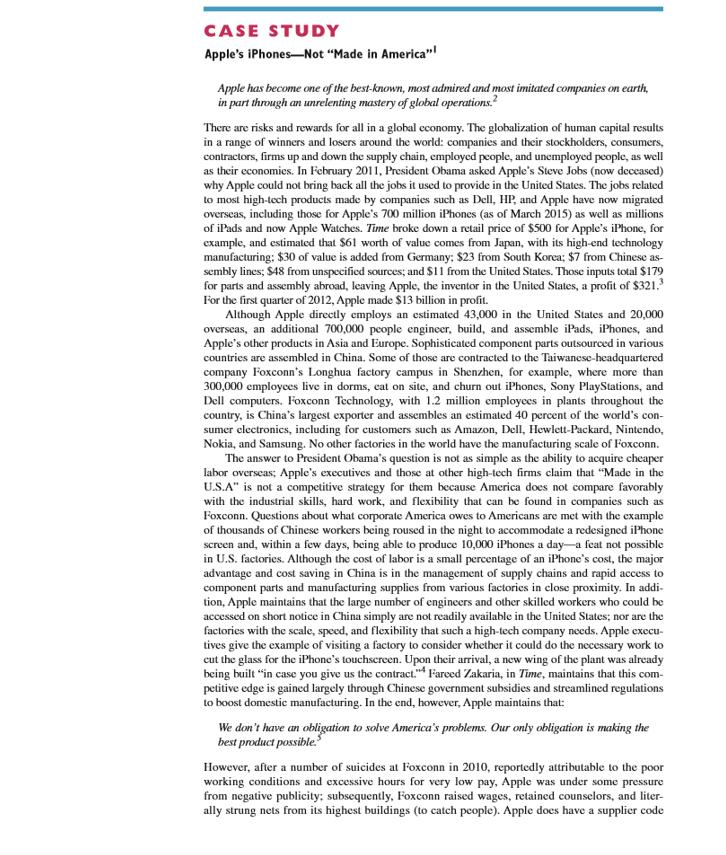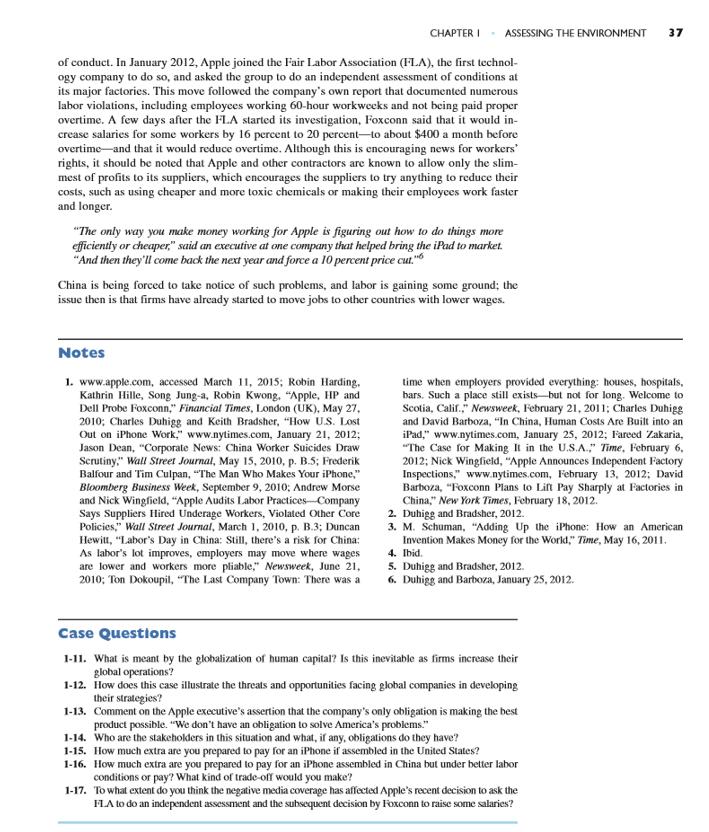Answered step by step
Verified Expert Solution
Question
1 Approved Answer
CASE STUDY Apple's iPhones-Not Made in America Apple has become one of the best-known, most admired and most imitated companies on earth, in part


CASE STUDY Apple's iPhones-Not "Made in America" Apple has become one of the best-known, most admired and most imitated companies on earth, in part through an unrelenting mastery of global operations. There are risks and rewards for all in a global economy. The globalization of human capital results in a range of winners and losers around the world: companies and their stockholders, consumers, contractors, firms up and down the supply chain, employed people, and unemployed people, as well as their economies. In February 2011, President Obama asked Apple's Steve Jobs (now deceased) why Apple could not bring back all the jobs it used to provide in the United States. The jobs related to most high-tech products made by companies such as Dell, HP, and Apple have now migrated overseas, including those for Apple's 700 million iPhones (as of March 2015) as well as millions of iPads and now Apple Watches. Time broke down a retail price of $500 for Apple's iPhone, for example, and estimated that $61 worth of value comes from Japan, with its high-end technology manufacturing: $30 of value is added from Germany: $23 from South Korea; $7 from Chinese as- sembly lines; $48 from unspecified sources; and $11 from the United States. Those inputs total $179 for parts and assembly abroad, leaving Apple, the inventor in the United States, a profit of $321.3 For the first quarter of 2012, Apple made $13 billion in profit. Although Apple directly employs an estimated 43,000 in the United States and 20,000 overseas, an additional 700,000 people engineer, build, and assemble iPads, iPhones, and Apple's other products in Asia and Europe. Sophisticated component parts outsourced in various countries are assembled in China. Some of those are contracted to the Taiwanese-headquartered company Foxconn's Longhua factory campus in Shenzhen, for example, where more than 300,000 employees live in dorms, eat on site, and churn out iPhones, Sony PlayStations, and Dell computers. Foxconn Technology, with 1.2 million employees in plants throughout the country, is China's largest exporter and assembles an estimated 40 percent of the world's con- sumer electronics, including for customers such as Amazon, Dell, Hewlett-Packard, Nintendo, Nokia, and Samsung. No other factories in the world have the manufacturing scale of Foxconn. The answer to President Obama's question is not as simple as the ability to acquire cheaper labor overseas; Apple's executives and those at other high-tech firms claim that "Made in the U.S.A" is not a competitive strategy for them because America does not compare favorably with the industrial skills, hard work, and flexibility that can be found in companies such as Foxconn. Questions about what corporate America owes to Americans are met with the example of thousands of Chinese workers being roused in the night to accommodate a redesigned iPhone screen and, within a few days, being able to produce 10,000 iPhones a day-a feat not possible in U.S. factories. Although the cost of labor is a small percentage of an iPhone's cost, the major advantage and cost saving in China is in the management of supply chains and rapid access to component parts and manufacturing supplies from various factories in close proximity. In addi- tion, Apple maintains that the large number of engineers and other skilled workers who could be accessed on short notice in China simply are not readily available in the United States; nor are the factories with the scale, speed, and flexibility that such a high-tech company needs. Apple execu- tives give the example of visiting a factory to consider whether it could do the necessary work to cut the glass for the iPhone's touchscreen. Upon their arrival, a new wing of the plant was already being built "in case you give us the contract.4 Fareed Zakaria, in Time, maintains that this com- petitive edge is gained largely through Chinese government subsidies and streamlined regulations to boost domestic manufacturing. In the end, however, Apple maintains that: We don't have an obligation to solve America's problems. Our only obligation is making the best product possible. However, after a number of suicides at Foxconn in 2010, reportedly attributable to the poor working conditions and excessive hours for very low pay, Apple was under some pressure from negative publicity; subsequently, Foxconn raised wages, retained counselors, and liter- ally strung nets from its highest buildings (to catch people). Apple does have a supplier code CHAPTERI ASSESSING THE ENVIRONMENT of conduct. In January 2012, Apple joined the Fair Labor Association (FLA), the first technol- ogy company to do so, and asked the group to do an independent assessment of conditions at its major factories. This move followed the company's own report that documented numerous labor violations, including employees working 60-hour workweeks and not being paid proper overtime. A few days after the FLA started its investigation, Foxconn said that it would in- crease salaries for some workers by 16 percent to 20 percent-to about $400 a month before overtime and that it would reduce overtime. Although this is encouraging news for workers' rights, it should be noted that Apple and other contractors are known to allow only the slim- mest of profits to its suppliers, which encourages the suppliers to try anything to reduce their costs, such as using cheaper and more toxic chemicals or making their employees work faster and longer. "The only way you make money working for Apple is figuring out how to do things more efficiently or cheaper," said an executive at one company that helped bring the iPad to market. "And then they'll come back the next year and force a 10 percent price cut. China is being forced to take notice of such problems, and labor is gaining some ground; the issue then is that firms have already started to move jobs to other countries with lower wages. Notes 1. www.apple.com, accessed March 11, 2015; Robin Harding. Kathrin Hille, Song Jung-a, Robin Kwong. "Apple, HP and Dell Probe Foxconn." Financial Times, London (UK), May 27, 2010; Charles Duhigg and Keith Bradsher, "How U.S. Lost Out on iPhone Work," www.nytimes.com, January 21, 2012; Jason Dean, "Corporate News: China Worker Suicides Draw Scrutiny," Wall Street Journal, May 15, 2010, p. B.5; Frederik Balfour and Tim Culpan, "The Man Who Makes Your iPhone," Bloomberg Business Week, September 9, 2010; Andrew Morse and Nick Wingfield, "Apple Audits Labor Practices Company Says Suppliers Hired Underage Workers, Violated Other Core Policies," Wall Street Journal, March 1, 2010, p. B.3; Duncan Hewitt, "Labor's Day in China: Still, there's a risk for China: As labor's lot improves, employers may move where wages are lower and workers more pliable," Newsweek, June 21, 2010; Ton Dokoupil, "The Last Company Town: There was a Case Questions 1-11. What is meant by the globalization of human capital? Is this inevitable as firms increase their global operations? 1-12. How does this case illustrate the threats and opportunities facing global companies in developing their strategies? 1-13. Comment on the Apple executive's assertion that the company's only obligation is making the best product possible. "We don't have an obligation to solve America's problems." 1-14. Who are the stakeholders in this situation and what, if any, obligations do they have? 1-15. How much extra are you prepared to pay for an iPhone if assembled in the United States? 1-16. How much extra are you prepared to pay for an iPhone assembled in China but under better labor conditions or pay? What kind of trade-off would you make? 1-17. To what extent do you think the negative media coverage has affected Apple's recent decision to ask the FLA to do an independent assessment and the subsequent decision by Foxconn to raise some salaries? 37 time when employers provided everything: houses, hospitals, bars. Such a place still exists but not for long. Welcome to Scotia, Calif.," Newsweek, February 21, 2011; Charles Duhigg and David Barboza, "In China, Human Costs Are Built into an iPad," www.nytimes.com, January 25, 2012; Fareed Zakaria, "The Case for Making It in the U.S.A.," Time, February 6, 2012; Nick Wingfield, "Apple Announces Independent Factory Inspections," www.nytimes.com, February 13, 2012; David Barboza, "Foxconn Plans to Lift Pay Sharply at Factories in China," New York Times, February 18, 2012. 2. Duhigg and Bradsher, 2012. 3. M. Schuman, "Adding Up the iPhone: How an American Invention Makes Money for the World," Time, May 16, 2011. 4. Ibid. 5. Duhigg and Bradsher, 2012. 6. Duhigg and Barboza, January 25, 2012.
Step by Step Solution
★★★★★
3.39 Rating (155 Votes )
There are 3 Steps involved in it
Step: 1
Answer 1 What is meant by the globalization of human capital Is this inevitable as firms increase their global operations The term of human capital refers to the way employees are spread across the gl...
Get Instant Access to Expert-Tailored Solutions
See step-by-step solutions with expert insights and AI powered tools for academic success
Step: 2

Step: 3

Ace Your Homework with AI
Get the answers you need in no time with our AI-driven, step-by-step assistance
Get Started


